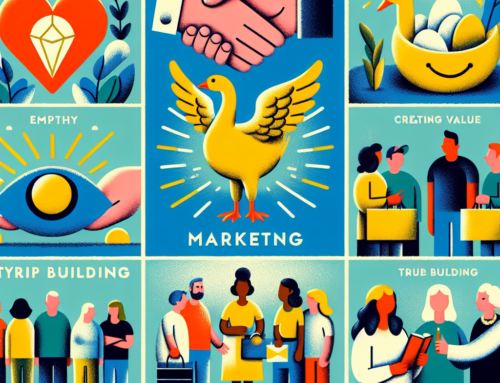
Understanding Permission Marketing: Seth Godin’s Revolutionary Approach
Seth Godin, a luminary in the world of marketing and branding, has consistently pushed the boundaries of conventional wisdom. One of his most groundbreaking contributions is the concept of permission marketing, a revolutionary approach that has redefined how businesses engage with their audiences. Unlike traditional marketing, which often relies on interrupting potential customers with unsolicited messages, permission marketing is built on the foundation of mutual respect and consent. This paradigm shift not only enhances the customer experience but also fosters deeper, more meaningful relationships between brands and their audiences.
To understand the essence of permission marketing, it is essential to grasp the fundamental principle that underpins it: earning the privilege to communicate with customers. In a world saturated with advertisements and promotional content, consumers have become adept at tuning out the noise. They are bombarded with countless messages daily, making it increasingly challenging for brands to capture their attention. Seth Godin recognized this challenge and proposed a solution that prioritizes the customer’s choice and preferences. By seeking permission before delivering marketing messages, brands can ensure that their communications are welcomed and valued.
One of the key advantages of permission marketing is its ability to build trust. When customers willingly opt-in to receive information from a brand, they are more likely to view the brand as credible and trustworthy. This trust is invaluable, as it forms the foundation for long-term customer loyalty. Moreover, permission marketing allows brands to tailor their messages to the specific interests and needs of their audience. This personalized approach not only increases the relevance of the content but also enhances the overall customer experience.
Transitioning from traditional marketing to permission marketing requires a shift in mindset. Brands must move away from the notion of reaching as many people as possible and instead focus on engaging with those who have expressed genuine interest. This shift can be challenging, as it necessitates a more strategic and thoughtful approach to marketing. However, the benefits far outweigh the initial effort. By cultivating a community of engaged and enthusiastic customers, brands can achieve higher conversion rates and more sustainable growth.
Another critical aspect of permission marketing is the emphasis on delivering value. Seth Godin advocates for providing customers with content that is not only relevant but also valuable. This could take the form of informative articles, exclusive offers, or entertaining content that resonates with the audience. By consistently delivering value, brands can reinforce the positive perception that customers have and encourage them to remain engaged over the long term.
Furthermore, permission marketing aligns seamlessly with the principles of inbound marketing. Both approaches prioritize attracting customers through valuable content and building relationships based on trust and consent. This alignment makes it easier for brands to integrate permission marketing into their broader marketing strategies. By leveraging tools such as email marketing, social media, and content marketing, brands can create a cohesive and effective permission marketing campaign.
In conclusion, Seth Godin’s concept of permission marketing represents a significant departure from traditional marketing practices. By prioritizing consent, trust, and value, brands can foster deeper connections with their audiences and achieve more sustainable success. While the transition to permission marketing may require a shift in mindset and strategy, the rewards are well worth the effort. As businesses continue to navigate the ever-evolving landscape of marketing, the principles of permission marketing will undoubtedly remain a cornerstone of effective and ethical brand communication.
The Power Of Tribes: Building Communities For Brand Loyalty
Seth Godin, a luminary in the realms of marketing and branding, has long championed the idea that successful brands are built not just on products or services, but on the communities they foster. Central to his philosophy is the concept of ”tribes,” which he eloquently explores in his book ”Tribes: We Need You to Lead Us.” According to Godin, tribes are groups of people connected to one another, to a leader, and to an idea. This interconnectedness forms the bedrock of brand loyalty, transforming customers into passionate advocates.
To understand the power of tribes, it’s essential to recognize that people inherently seek connection and belonging. In a world saturated with choices, individuals gravitate towards brands that resonate with their values and aspirations. Godin posits that brands can no longer rely solely on traditional advertising to capture attention. Instead, they must cultivate a sense of community, where members feel seen, heard, and valued. This shift from transactional to relational marketing is pivotal in building lasting loyalty.
One of the key insights from Godin’s work is the importance of leadership within these tribes. Effective leaders are not just figureheads; they are catalysts for change and inspiration. They articulate a vision that aligns with the tribe’s values and aspirations, creating a shared sense of purpose. This vision acts as a magnet, attracting like-minded individuals who are eager to contribute and participate. By fostering a culture of inclusivity and engagement, leaders can transform passive consumers into active participants.
Moreover, Godin emphasizes the role of storytelling in building tribes. Stories are powerful tools for conveying values, creating emotional connections, and inspiring action. Brands that master the art of storytelling can weave narratives that resonate deeply with their audience, fostering a sense of identity and belonging. These stories are not just about the brand itself but about the shared journey and experiences of the tribe. They celebrate the collective achievements and milestones, reinforcing the bonds that hold the community together.
Transitioning from theory to practice, Godin provides actionable strategies for building and nurturing tribes. One such strategy is to identify and connect with the ”sneezers” within the community. These are the individuals who are passionate about the brand and have the influence to spread the word. By empowering these advocates, brands can amplify their message and reach a wider audience. Additionally, creating platforms for interaction and engagement, such as social media groups, forums, or events, can facilitate deeper connections among tribe members.
Another crucial aspect is authenticity. In an age where consumers are increasingly skeptical of corporate motives, authenticity is a currency that brands cannot afford to ignore. Godin argues that brands must be transparent, genuine, and consistent in their actions and communications. This authenticity builds trust, which is the cornerstone of any strong community. When tribe members trust the brand and its leaders, they are more likely to remain loyal, even in the face of challenges or competition.
In conclusion, Seth Godin’s insights into the power of tribes offer a transformative approach to marketing and branding. By focusing on building communities rooted in shared values and purpose, brands can foster deep, enduring loyalty. Through effective leadership, compelling storytelling, and genuine authenticity, they can create tribes that not only support the brand but also drive its growth and evolution. As Godin aptly puts it, ”People don’t buy goods and services. They buy relations, stories, and magic.” Embracing this philosophy can unlock the true potential of brand loyalty in today’s interconnected world.
Purple Cow: How To Stand Out In A Crowded Market
In the ever-evolving landscape of marketing and branding, few voices resonate as profoundly as that of Seth Godin. His insights have shaped the way businesses approach their strategies, particularly when it comes to standing out in a crowded market. One of his most influential concepts is encapsulated in his book ”Purple Cow,” which delves into the necessity of being remarkable in order to capture attention and drive success.
To understand the essence of the ”Purple Cow” philosophy, it’s essential to grasp the metaphor itself. Imagine driving through the countryside, passing field after field of cows. Initially, the sight might be charming, but soon it becomes monotonous. Now, picture spotting a purple cow amidst the sea of brown and black. Instantly, it grabs your attention because it is unique and unexpected. This is precisely what Godin advocates for in marketing: the creation of products and services that are so remarkable they cannot be ignored.
Transitioning from the metaphor to practical application, Godin emphasizes that being remarkable doesn’t necessarily mean being extravagant or outlandish. Instead, it involves identifying what makes your offering distinct and leveraging that uniqueness to create a memorable impression. This could be an innovative feature, exceptional customer service, or a compelling brand story. The key is to ensure that this distinctiveness is not just a gimmick but a genuine value proposition that resonates with your target audience.
Moreover, Godin points out that in today’s saturated market, traditional advertising methods are no longer as effective. Consumers are bombarded with countless messages daily, making it crucial for brands to cut through the noise. This is where the concept of the ”Purple Cow” becomes even more relevant. By focusing on creating something truly remarkable, businesses can generate organic buzz and word-of-mouth marketing, which are far more powerful than conventional advertisements.
Another critical aspect of standing out, as Godin discusses, is the willingness to take risks. Playing it safe often leads to mediocrity, which is the antithesis of being remarkable. Embracing innovation and being open to experimentation can lead to breakthroughs that set a brand apart. However, this also means being prepared for potential failures and learning from them. The path to creating a ”Purple Cow” is rarely linear, but the rewards of standing out far outweigh the risks.
Furthermore, Godin highlights the importance of understanding and connecting with your audience. A remarkable product or service is only effective if it aligns with the needs and desires of the people you aim to serve. This requires deep market research and a genuine commitment to listening to your customers. By doing so, businesses can tailor their offerings to meet specific demands, thereby enhancing their uniqueness and appeal.
In addition to these strategies, Godin also underscores the significance of authenticity. In an age where consumers are increasingly skeptical of marketing tactics, authenticity can be a powerful differentiator. Brands that are transparent, honest, and true to their values are more likely to build trust and loyalty among their audience. This authenticity should permeate every aspect of the brand, from its messaging to its customer interactions.
In conclusion, Seth Godin’s ”Purple Cow” provides invaluable insights into how businesses can stand out in a crowded market. By focusing on being remarkable, embracing risk, understanding the audience, and maintaining authenticity, brands can create a lasting impact. As the marketing landscape continues to evolve, these principles remain timeless, offering a roadmap for success in an increasingly competitive world.
The Importance Of Storytelling In Branding: Lessons From Seth Godin
Seth Godin, a luminary in the realms of marketing and branding, has long championed the power of storytelling as a cornerstone of effective branding. His insights reveal that in a world saturated with advertisements and marketing messages, it is the compelling narrative that cuts through the noise and resonates with audiences. Storytelling, according to Godin, is not merely a tool but an essential element that breathes life into a brand, making it memorable and relatable.
To understand the importance of storytelling in branding, one must first appreciate the human inclination towards stories. From ancient myths to modern-day novels, stories have always been a fundamental part of human culture. They evoke emotions, create connections, and foster a sense of belonging. Godin emphasizes that brands, much like stories, need to evoke these same feelings to build a loyal customer base. By weaving a narrative that aligns with the values and aspirations of their audience, brands can create a deeper, more meaningful connection.
Moreover, Godin points out that storytelling in branding is not just about the content but also about the delivery. The way a story is told can significantly impact its effectiveness. Authenticity is key here. Consumers today are savvy and can easily detect inauthenticity. Therefore, brands must ensure that their stories are genuine and reflect their true identity. This authenticity builds trust, which is crucial for long-term brand loyalty.
Transitioning from the concept of authenticity, Godin also highlights the importance of consistency in storytelling. A brand’s narrative should be consistent across all platforms and touchpoints. This consistency helps reinforce the brand’s message and makes it more recognizable. For instance, if a brand’s story revolves around sustainability, this theme should be evident in everything from their marketing campaigns to their product packaging. Consistency not only strengthens the brand’s identity but also ensures that the message is clear and unambiguous.
Furthermore, Godin underscores the role of the audience in storytelling. He believes that the most powerful brand stories are those that invite the audience to be a part of the narrative. This participatory approach makes the audience feel valued and engaged. For example, brands can encourage customers to share their own stories and experiences related to the brand. This not only enriches the brand’s narrative but also fosters a sense of community among its customers.
In addition to engaging the audience, Godin advises brands to focus on the emotional aspect of storytelling. Emotions are a powerful driver of human behavior, and a story that evokes strong emotions is more likely to be remembered and acted upon. Whether it’s joy, nostalgia, or even a sense of urgency, tapping into these emotions can make a brand’s story more compelling and impactful.
Lastly, Godin reminds us that storytelling in branding is an ongoing process. It is not a one-time effort but a continuous journey. Brands must constantly evolve their narratives to stay relevant and resonate with their audience. This requires staying attuned to changes in consumer preferences and societal trends, and being willing to adapt the story accordingly.
In conclusion, Seth Godin’s insights on storytelling in branding offer valuable lessons for anyone looking to build a strong, memorable brand. By focusing on authenticity, consistency, audience engagement, emotional resonance, and adaptability, brands can craft stories that not only capture attention but also foster lasting connections with their audience. In a world where consumers are bombarded with choices, it is these compelling narratives that set brands apart and drive their success.
Embracing The Dip: Knowing When To Quit And When To Persevere
Seth Godin, a luminary in the realms of marketing and branding, has long been a source of wisdom for entrepreneurs and business leaders. One of his most compelling concepts is ”The Dip,” a term he uses to describe the challenging period that separates beginners from true masters. Understanding ”The Dip” is crucial for anyone looking to navigate the often tumultuous waters of business and personal growth. It is the point where initial enthusiasm wanes, and the real work begins. This phase can be incredibly daunting, but it is also where the most significant opportunities for growth and success lie.
Godin emphasizes that recognizing ”The Dip” is the first step towards mastering it. Many people mistakenly interpret this challenging period as a sign of failure or a reason to quit. However, Godin argues that ”The Dip” is a natural part of any worthwhile endeavor. It is a test of your commitment and a filter that separates those who are truly dedicated from those who are merely interested. By understanding that ”The Dip” is an inevitable part of the journey, you can better prepare yourself mentally and emotionally to face it head-on.
Transitioning from understanding ”The Dip” to knowing when to quit and when to persevere is where the real mastery lies. Godin advises that quitting is not inherently negative; in fact, strategic quitting can be a powerful tool. The key is to quit the right things at the right time. For instance, if you find yourself in a ”cul-de-sac,” a situation where no amount of effort will lead to significant progress, quitting can free up valuable resources and energy that can be better invested elsewhere. On the other hand, if you are in ”The Dip,” quitting would mean giving up just before the breakthrough.
To navigate this delicate balance, Godin suggests a few practical strategies. First, set clear, long-term goals and use them as a compass to guide your decisions. When you have a clear vision of what you want to achieve, it becomes easier to distinguish between temporary setbacks and dead ends. Additionally, seek feedback from trusted mentors or peers who can provide an objective perspective. Sometimes, an outside viewpoint can help you see things more clearly and make more informed decisions.
Moreover, Godin highlights the importance of passion and purpose in enduring ”The Dip.” When you are deeply passionate about your work and have a strong sense of purpose, you are more likely to persevere through tough times. Passion fuels resilience, and purpose provides direction. Together, they form a powerful combination that can help you push through ”The Dip” and emerge stronger on the other side.
In conclusion, embracing ”The Dip” is about recognizing it as a natural and necessary part of any significant journey. By understanding its role, knowing when to quit strategically, and leveraging passion and purpose, you can navigate this challenging phase more effectively. Seth Godin’s insights offer a valuable framework for anyone looking to achieve mastery in their field. By applying these principles, you can turn ”The Dip” from a daunting obstacle into a stepping stone towards greater success and fulfillment.
We have lots of exciting coming events in Entrepreneurship, Investing and Personal Development. You can find them all here:
www.swedishwealthinstitute.se/events




